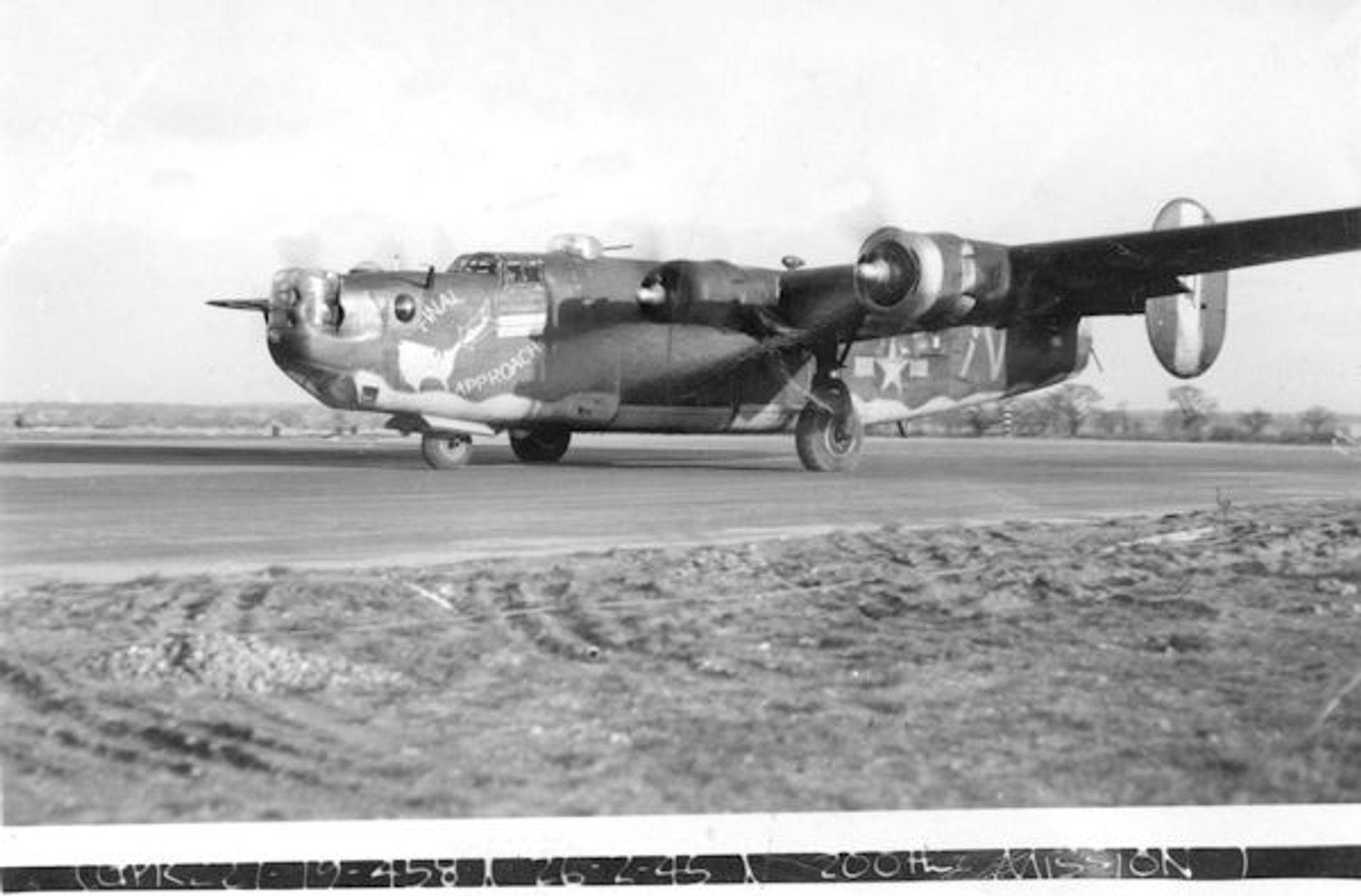Burman Crew – Assigned 752nd Squadron – November 18, 1944

Back Row: Harvey Putman – N, Elmer Etscheid – CP, Ed Landon – B, Bob Burman – P
Front Row: Bob Groh – TG, Enrico Ciotti – WG, Gene Gabay – WG, Junior Clark – RO, Al Ebbing – TT/E, Stanley Sargut – NTG
(Photo: Alice Burman)
Removed from Flight Status – April 12, 1945
| Rank | Name | Serial # | Crew Position | Date | Status | Comments |
|---|---|---|---|---|---|---|
| 1Lt | Robert W Burman | 0718854 | Pilot | 12-Apr-45 | FEH | Rest Home Leave |
| 2Lt | Elmer G Etscheid | 0829442 | Co-pilot | 14-Apr-45 | FEH | Leave |
| 2Lt | Harvey I Putman | 02065183 | Navigator | 12-Apr-45 | FEH | Rest Home Leave |
| 2Lt | Edward Landon | Bombardier | UNK | Not assigned w/crew | ||
| T/Sgt | Junior K Clark | 36726064 | Radio Operator | 12-Apr-45 | FEH | Rest Home Leave |
| T/Sgt | Alfred J Ebbing | 16074864 | Flight Engineer | 12-Apr-45 | FEH | Rest Home Leave |
| Sgt | Eugene T Gabay | 32825102 | Armorer-Gunner | 09-Apr-45 | KIA | Kings, NY |
| S/Sgt | Enrico R Ciotti | 33787934 | Waist Gunner | 09-Apr-45 | KIA | Chester, PA |
| S/Sgt | Stanley F Sargut | 11058188 | Nose Turret Gunner | 12-Apr-45 | FEH | Rest Home Leave |
| S/Sgt | Robert W Groh | 36686088 | Tail Turret Gunner | 10-Apr-45 | FEH | Reclassified MOS 611 to 612 |
Robert W. Burman and crew arrived at Horsham in mid-November and completed 24 missions between December 1944 and April 1945. On their third combat mission on New Year’s Eve 1944, the crew were forced down in Allied territory on the Continent. They arrived back at Horsham after several days in Belgium.
The crew was also the subject of a “photo-shoot” by the Group’s photographer’s on February 26, 1945, the 458th’s 200th Mission. They flew an original group Liberator, Final Approach on which would be her 92nd mission.
Their last mission as a crew was to an airfield near Lechfeld, Germany on April 9, 1945. Once again, due to battle damage the crew were forced to make an emergency landing on the Continent, but this time two crew members were killed in action. It was after this mission that the remaining crew memebrs were removed from combat operations. They were given the task of ferrying personnel from Horsham St. Faith (which was also the home of the 96th Combat Bomb Wing and the HQ of 2nd Air Division) all over England and the Continent.
Missions
| Date | Target | 458th Msn | Pilot Msn | Serial | RCL | Sqdn | A/C Msn | A/C Name | Comments |
|---|---|---|---|---|---|---|---|---|---|
| 12-Dec-44 | HANAU | 156 | 1 | 41-29567 | G | 7V | 8 | MY BUNNIE / BAMBI | |
| 18-Dec-44 | KOBLENZ | REC | -- | 42-52457 | Q | 7V | -- | FINAL APPROACH | RECALL DUTCH ISLE |
| 30-Dec-44 | NEUWIED | 161 | 2 | 42-52457 | Q | 7V | 74 | FINAL APPROACH | |
| 31-Dec-44 | KOBLENZ | 162 | 3 | 42-100407 | R | 7V | 62 | LITTLE LAMBSY DIVEY | CRASH LAND ON CONT |
| 13-Jan-45 | KAISERLAUTERN | 169 | 4 | 42-95179 | X | 7V | 71 | HERE I GO AGAIN | |
| 16-Jan-45 | MAGDEBURG | 171 | 5 | 44-40281 | Q | J4 | 29 | A DOG'S LIFE | ON FP FLYING 44-40475D |
| 31-Jan-45 | BRUNSWICK | 176 | 6 | 44-40475 | D | 7V | 22 | JOLLY ROGER | RECALL - SORTIE CREDIT |
| 06-Feb-45 | MAGDEBURG | 178 | 7 | 42-95316 | H | 7V | 73 | PRINCESS PAT | |
| 16-Feb-45 | OSNABRUCK | 183 | 8 | 42-95316 | H | 7V | 77 | PRINCESS PAT | |
| 19-Feb-45 | MESCHADE | 184 | 9 | 42-95316 | H | 7V | 78 | PRINCESS PAT | |
| 23-Feb-45 | GERA-REICHENBACH | 187 | 10 | 42-51270 | A | 7V | 12 | MY BUNNIE II | |
| 26-Feb-45 | BERLIN | 190 | 11 | 42-52457 | Q | 7V | 92 | FINAL APPROACH | GROUP 200TH MISSION |
| 28-Feb-45 | BIELEFELD | 192 | 12 | 41-29340 | N | 7V | 65 | YANKEE BUZZ BOMB | |
| 02-Mar-45 | MAGDEBURG | 194 | 13 | 42-51514 | B | 7V | 18 | BIG CHIEF LIL' BEAVER | |
| 04-Mar-45 | STUTTGART | 196 | 14 | 41-29567 | G | 7V | 14 | MY BUNNIE / BAMBI | |
| 05-Mar-45 | HARBURG | 197 | 15 | 42-51206 | S | 7V | 47 | THE PIED PIPER | |
| 10-Mar-45 | ARNSBURG | 201 | 16 | 42-51270 | A | 7V | 21 | MY BUNNIE II | |
| 14-Mar-45 | HOLZWICKEDE | 203 | 17 | 44-40475 | D | 7V | 34 | JOLLY ROGER | |
| 18-Mar-45 | BERLIN | 206 | 18 | 42-52457 | Q | 7V | 104 | FINAL APPROACH | |
| 21-Mar-45 | HESEPE | 209 | 19 | 41-29352 | K | 7V | 84 | WOLVE'S LAIR | |
| 23-Mar-45 | OSNABRUCK | 211 | 20 | 42-51110 | M | 7V | 95 | TOP O' THE MARK | |
| 24-Mar-45 | KIRKOFF | 213 | 21 | 42-50502 | E | 7V | 54 | LARRUPIN' LINDA | |
| 31-Mar-45 | BRUNSWICK | 216 | 22 | 42-50502 | E | 7V | 56 | LARRUPIN' LINDA | |
| 04-Apr-45 | PERLEBERG | 217 | 23 | 42-50502 | E | 7V | 57 | LARRUPIN' LINDA | |
| 05-Apr-45 | PLAUEN | 218 | 24 | 42-50502 | E | 7V | 58 | LARRUPIN' LINDA | |
| 07-Apr-45 | KRUMMEL | 220 | 25 | 42-50502 | E | 7V | 60 | LARRUPIN' LINDA | |
| 08-Apr-45 | UNTERSCHLAUERSBACH | 221 | 26 | 42-50502 | E | 7V | 61 | LARRUPIN' LINDA | |
| 09-Apr-45 | LECHFELD | 222 | 27 | 42-95316 | H | 7V | 103 | PRINCESS PAT | EMERG LAND BELGIUM |
December 31, 1944

B-24J-100-CO 42-100407 J3 A Little Lambsy Divey
(Color plate by Mike Bailey)
“My name is Alfred J. Ebbing, and I was the flight engineer and top turret gunner on the B-24. A G.I. stationed on the airbase at Florennes, Belgium took the picture below on December 31, 1944. The person standing by the nose turret is myself, T/Sgt Alfred J. Ebbing of the 458th BG Heavy and member of Lt. Bob Burman’s crew. Our crew consisted of Lt. Bob Burman, pilot; Lt. Elmer Etschied, co-pilot; Lt. Harvey Putman, navigator; T/Sgt Alfred J. Ebbing, flight engineer and top turret gunner; S/Sgt Junior Clark, radio operator; S/Sgt Enrico Ciotti, waist gunner; S/Sgt Eugene Gabay, waist gunner; S/Sgt Stanley Sargut, nose gunner, and S/Sgt Robert Groh, tail gunner.
“On December 30, 1944 on our third mission, we bombed a RR bridge in Koblenz, Germany without any problems or incursions with the enemy. On New Year’s Eve, the next day, we were sent on mission number four – back to Koblenz, Germany to wipe out another RR bridge. Before we left our airbase in Horsham St. Faith in England, the ground crew told me that one bomb might hang up in the bomb rack. With that information, we went through the emergency procedures to release the bombs. The bomb thought to have a problem released without any malfunctions. Unfortunately, another one of our four bombs ended up stuck in the bomb rack and I was unable to release it. I put the safety pin back in the bomb. On this particular mission we were carrying four 2000 lb. bombs, 2300 gallons of fuel and flying at 22,000 feet trying to get above the flak. Air temperature was -40 degrees F. On this mission we encountered heavy flak and a lot of enemy fighters. The pilot had to feather #2 and #4 engines as we were losing oil and fuel out of both engines. We had also taken flak in the hydraulics to the nose gear as well as the back up emergency hand procedures. I was unable to lower the nose gear. While in flight returning to our base, I proceeded to inspect the nose gear and found it totally inoperable. I started up to remind the pilot of the bomb, and tell him we had no nose gear. While doing so, I looked down and saw the ground coming up very quick through the open bomb bay door and assumed a crash position.
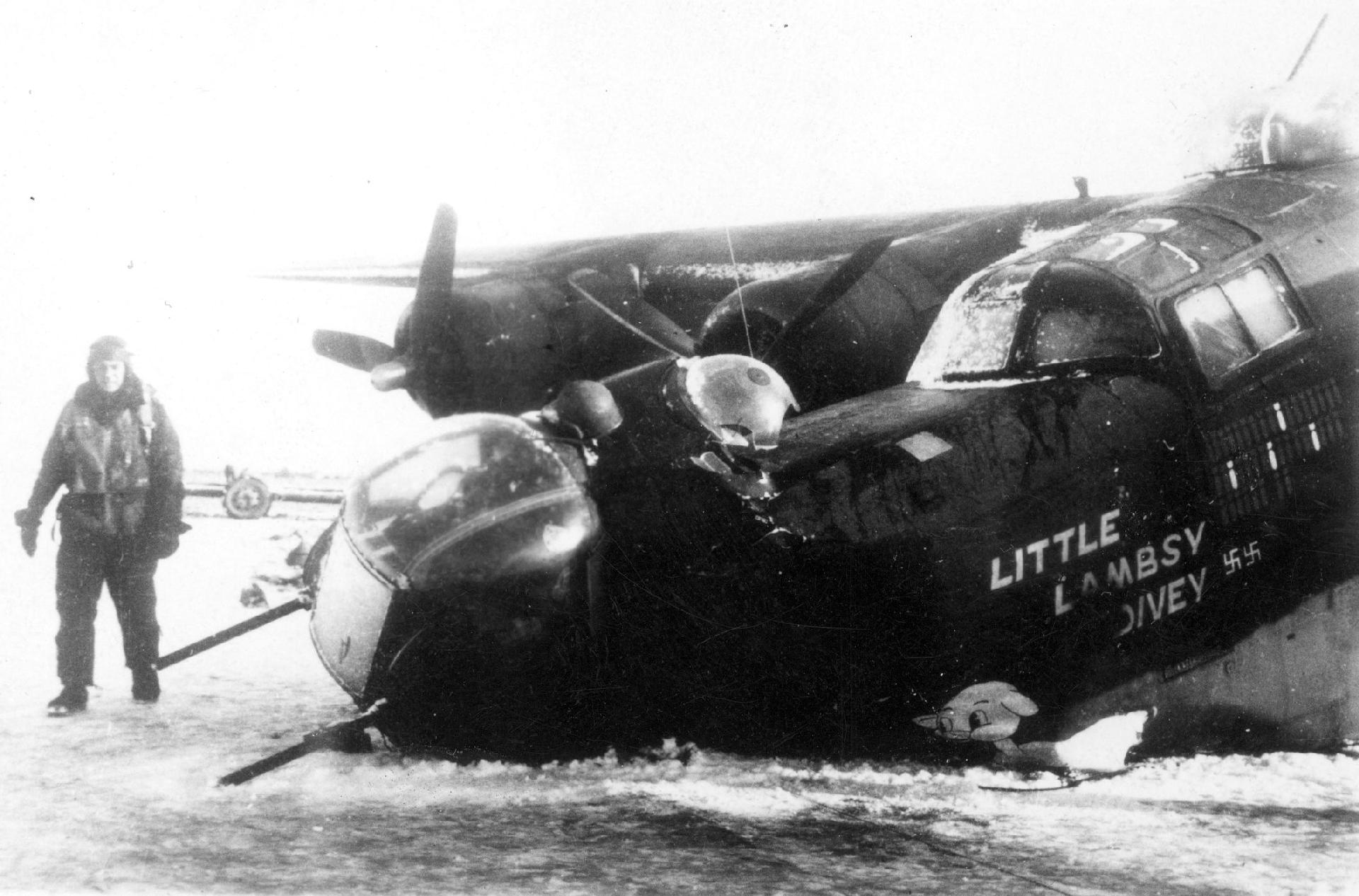
Flight Engineer Alfred Ebbing looks over the aircraft after the crew’s landing in a field in Belgium.
“When we hit the runway with no nose gear and two engines feathered the pilot had little control [of the] plane causing us to leave the runway, hitting bumpy terrain [shaking] the bomb loose, dropping it to the ground, causing the plane to drop on the nose turret nearly breaking it off. Fortunately everyone walked away from the plane unhurt.”
After this ordeal of crash landing on a base in Belgium, it took us four days to reach our [home] base back in England, as we had to wait our turn to fly back in a cargo plane. Our next mission wasn’t until January 13, 1945.
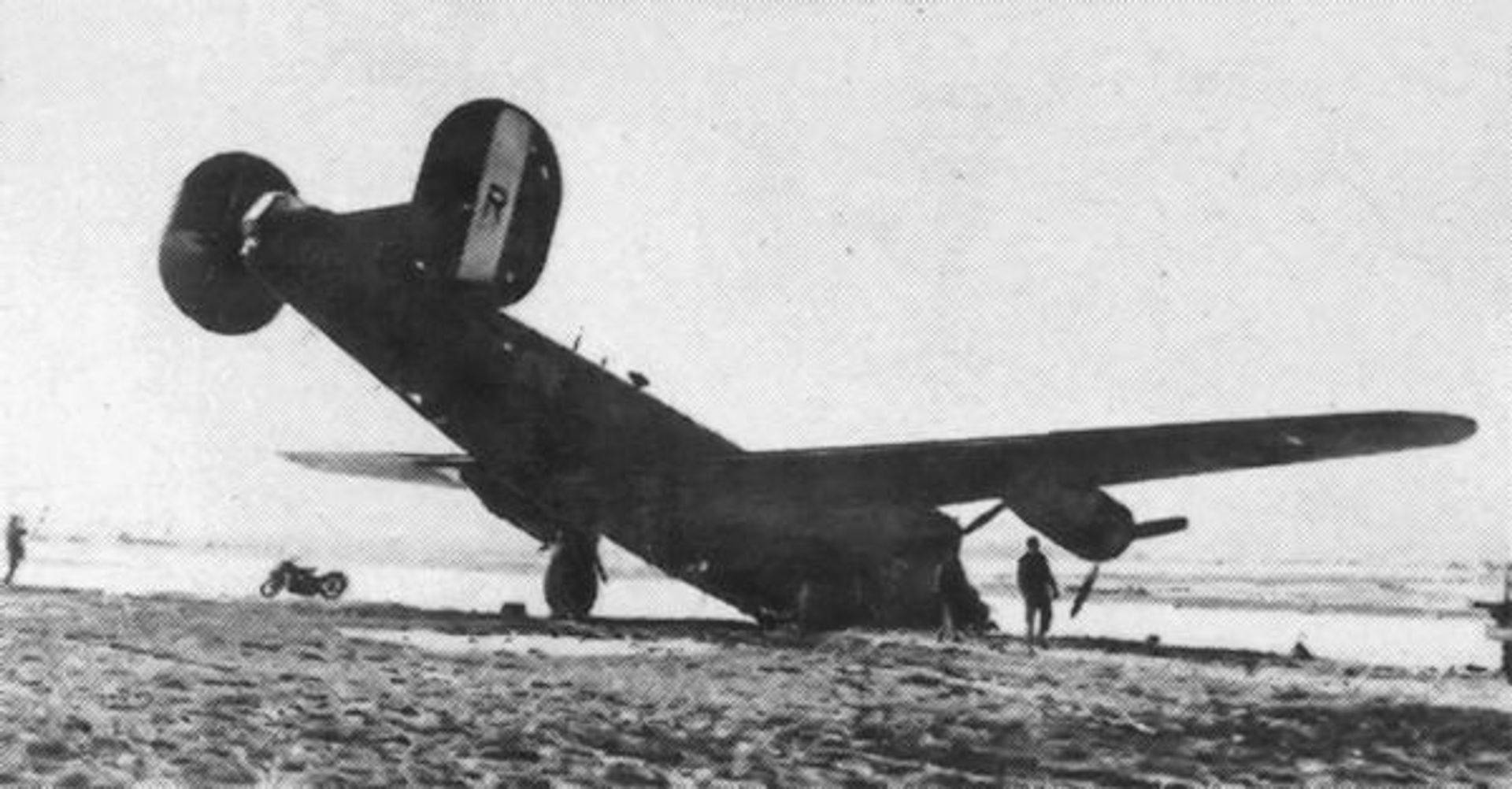
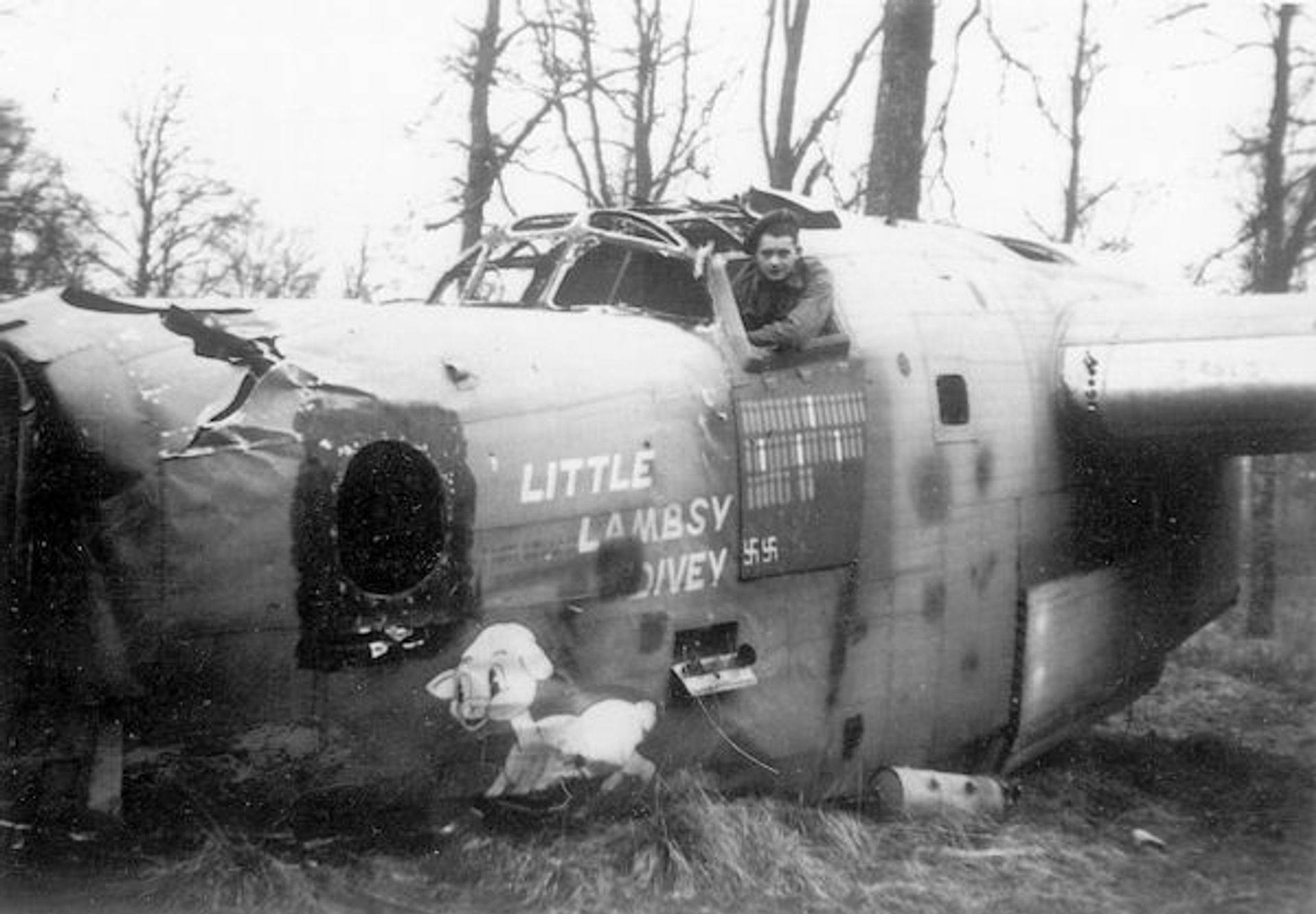
Little Friend
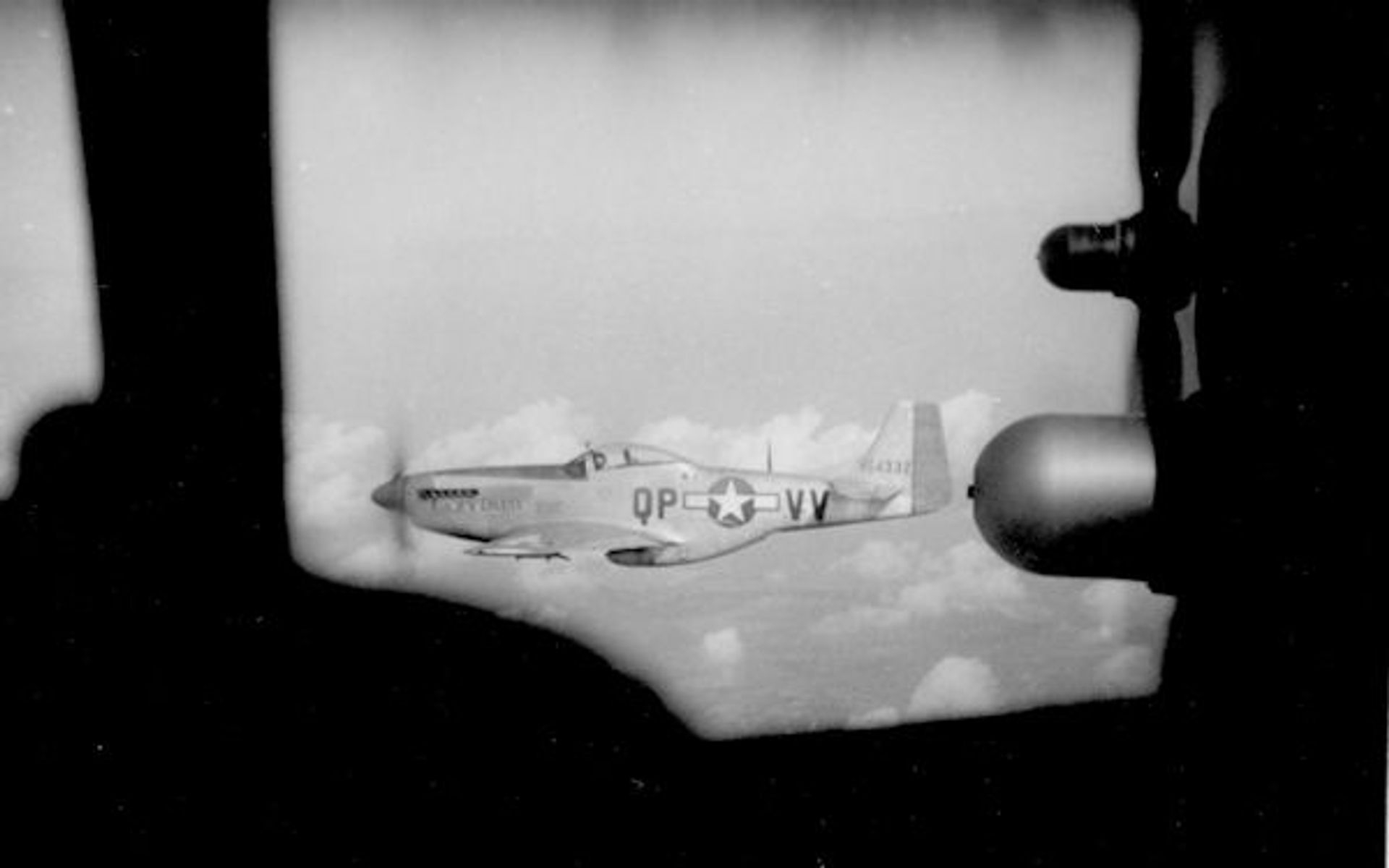
February 26, 1945 – 200th Mission
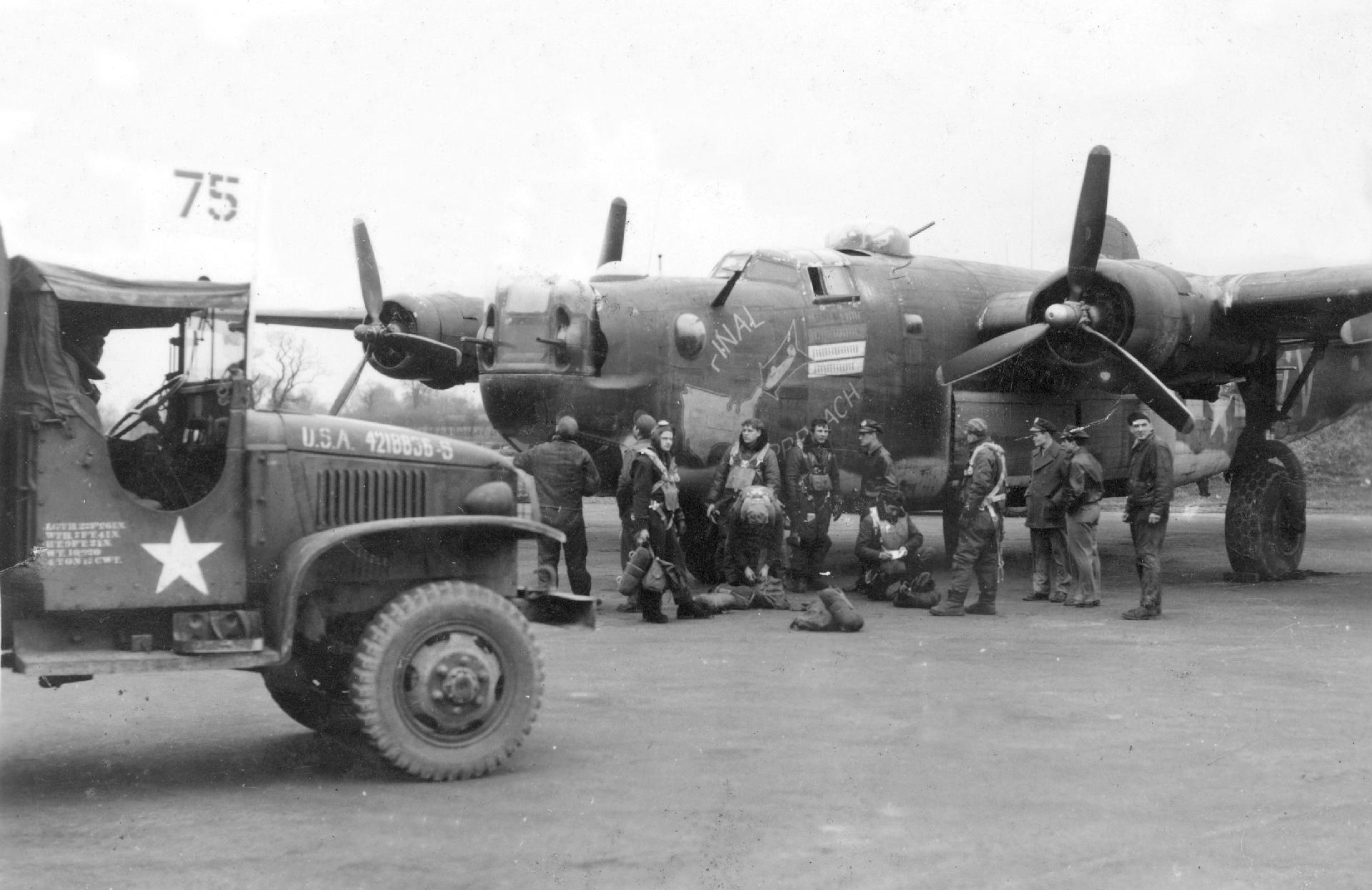
Burman crew preparing to board Final Approach for the 458th’s 200th combat mission
Taxiing out (below)
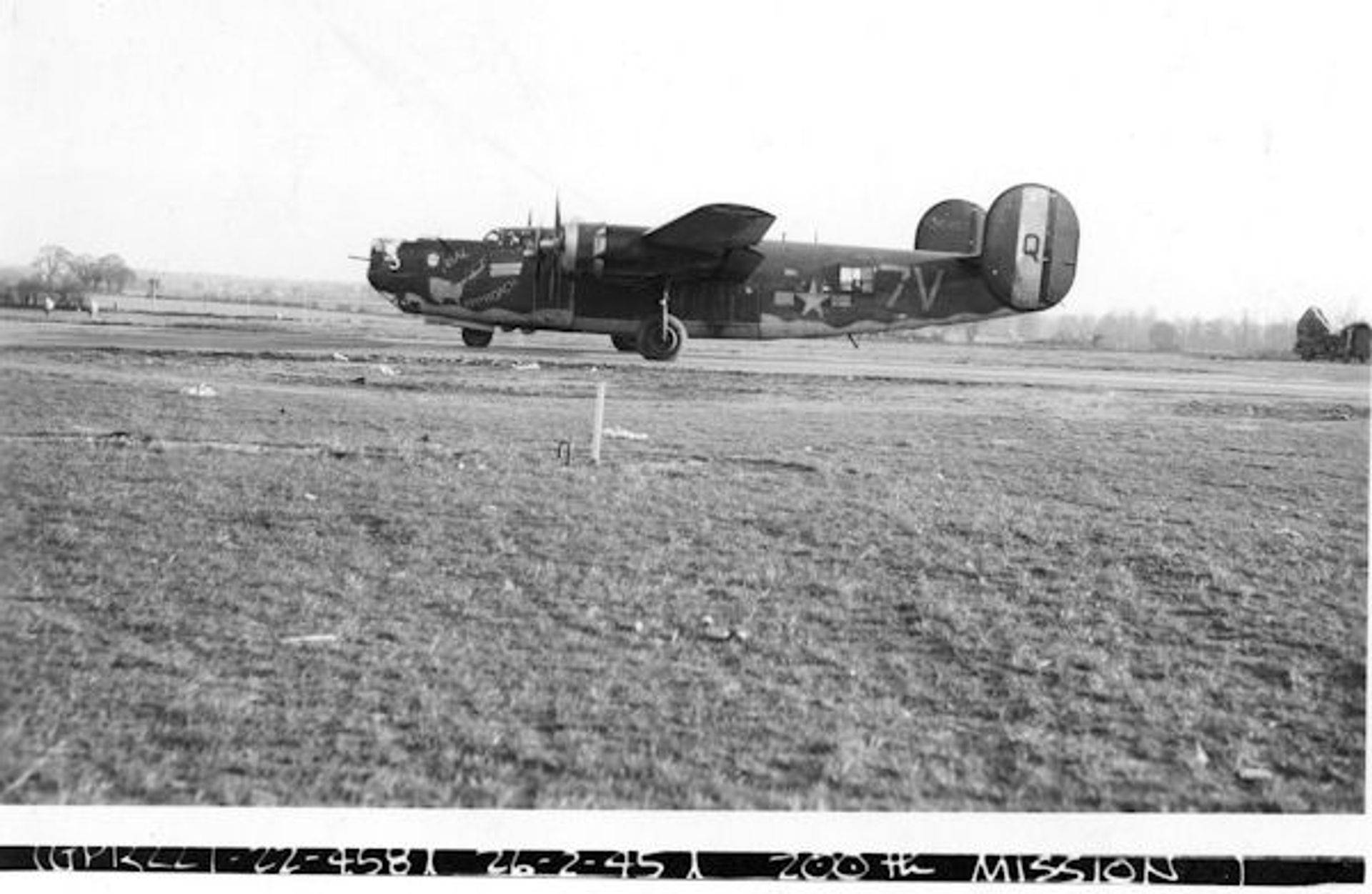
April 9, 1945 – Target: Lechfeld A/F
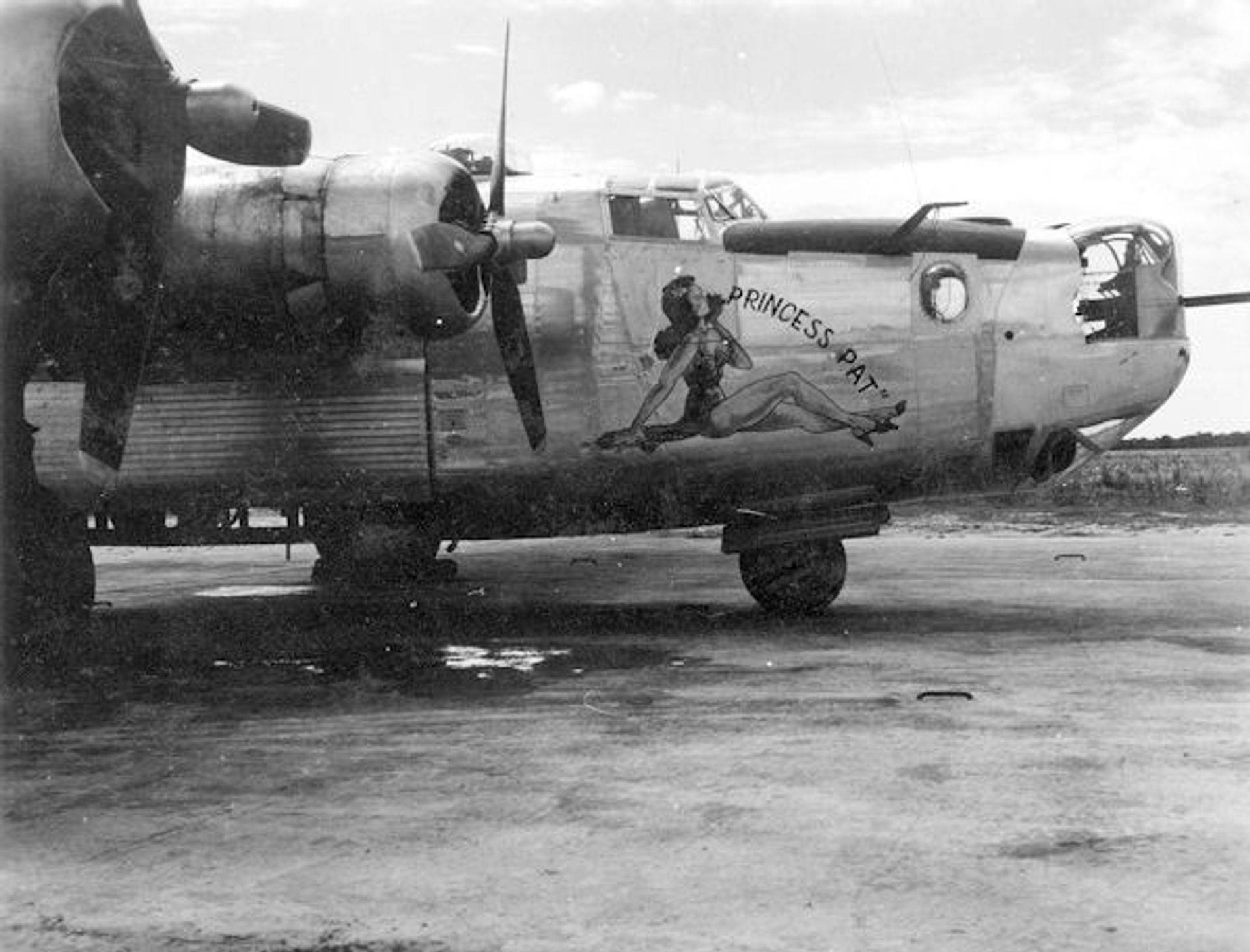
B-24H-30-FO 42-95316 7V H Princess Pat
(Photo: Bill Case)
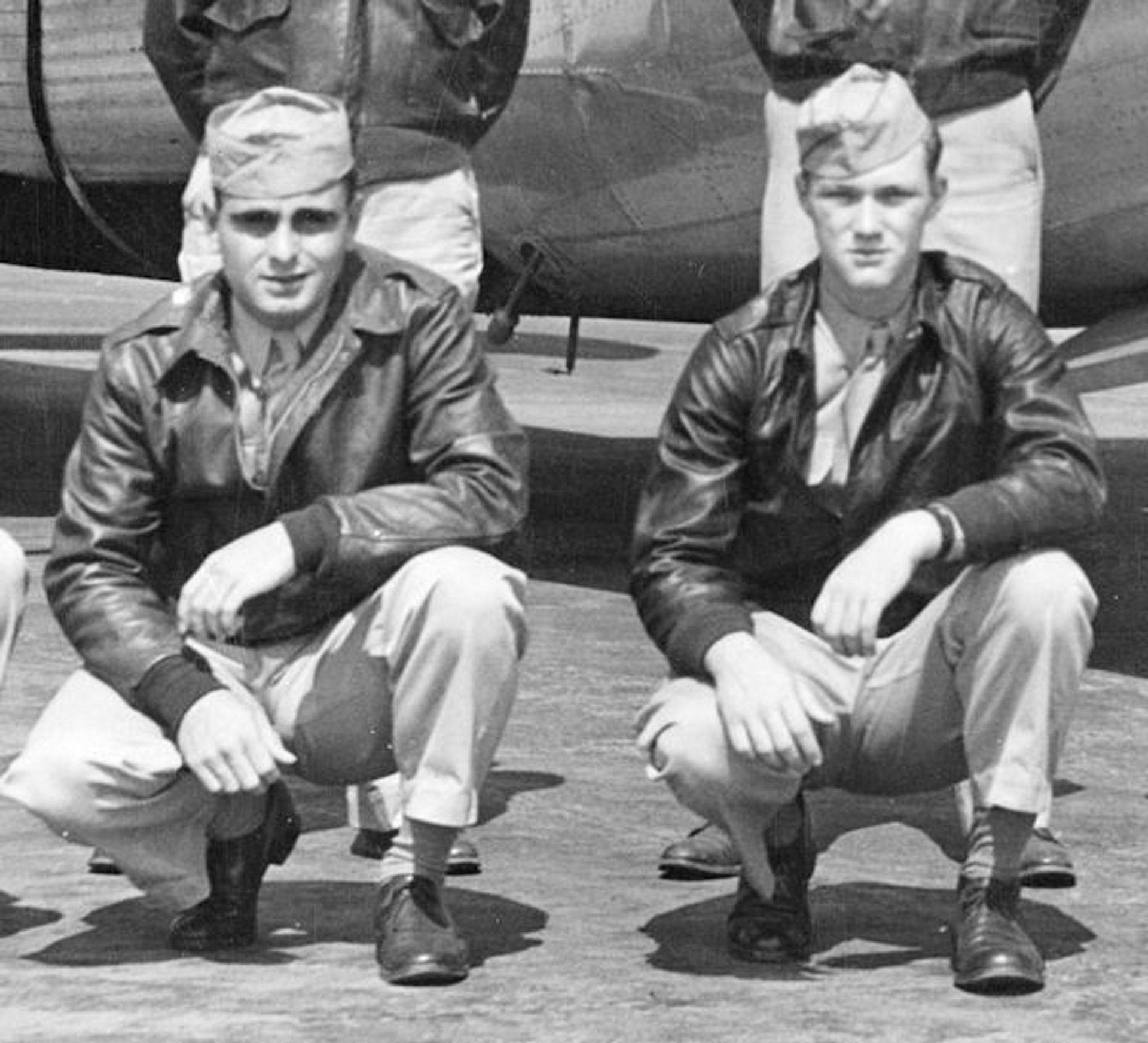
Distinguished Flying Crosses
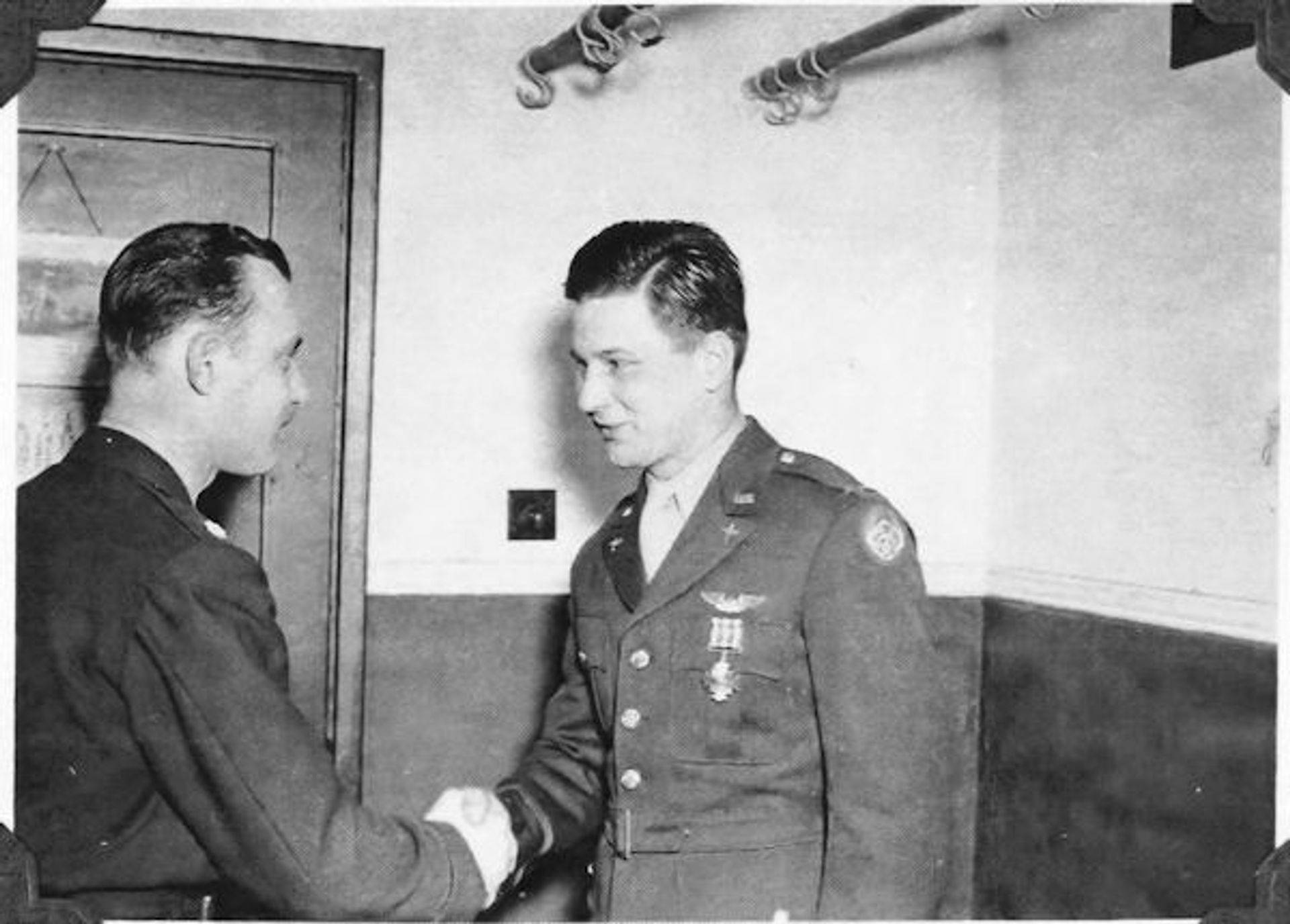
ROBERT W. BURMAN, 0-718854, Second Lieutenant, Army Air Forces, United States Army. For extraordinary achievement while serving as Pilot of a B-24 aircraft on a bombing mission to Germany, 31 December 1944. Lieutenant Burman’s aircraft was severely damaged by flak while over the target. Three engines were hit, one requiring feathering, considerable structural damage was inflicted, hydraulic lines severed and all radio equipment rendered inoperative. Lieutenant Burman skillfully maintained control of his aircraft and successfully released his bombs in the target area. Returning to friendly territory he expertly landed the damaged aircraft on two engines with the nose wheel jammed in the up position and a 2,000 pound bomb in the bomb bay without further damage or injury to the crew. The superior flying ability and airmanship displayed by Lieutenant Burman on this occasion reflect the highest credit upon himself and the Armed Forces of the United States. Entered military service from Washington.
ROBERT W. BURMAN, 0-718854, First Lieutenant, Army Air Forces, United States Army. For extraordinary achievement, while serving as Pilot of a B-24 airplane on a bombing mission to Germany, 9 April 1945. Lieutenant Burman’s aircraft was hit by flak while over the target and suffered considerable structural damage. Lieutenant Burman skilfully [sic] maintained control of his aircraft and successfully bombed the target. The prompt action, presence of mind, and superior flying ability displayed by Lieutenant Burman on this occasion reflect the highest credit upon himself and the Armed Forces of the United States.
(Photos and documents: Alice Burman)
Public Relations Article – May 1945
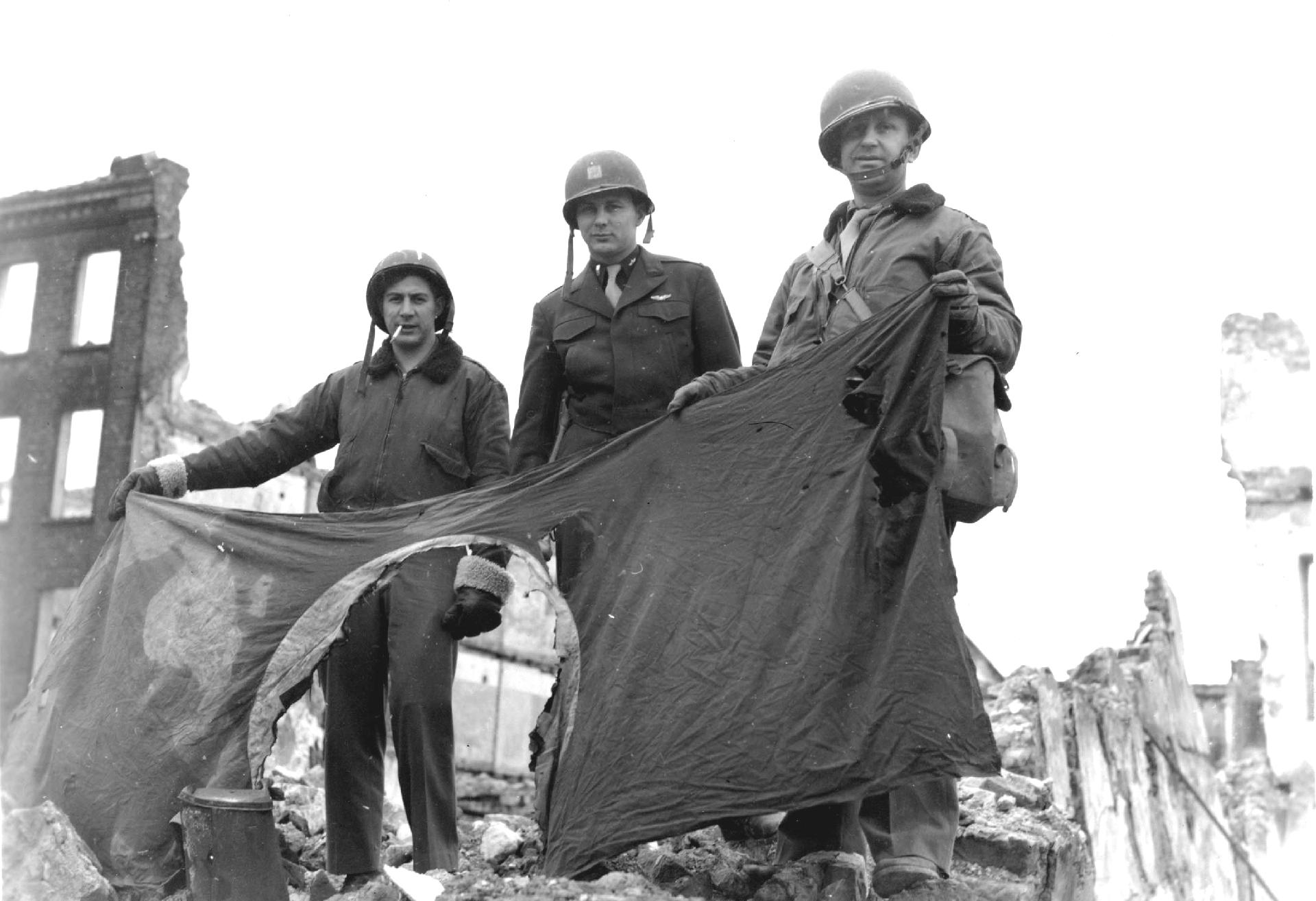
AN EIGHTH AIR FORCE LIBERATOR STATION, ENGLAND – Technical Sgt. Alfred J. Ebbing of Quincy, Ill. was the Flight Engineer of the B-24 liberator bomber that recently took ground personnel of the 458th Bombardment Group who had been awarded the Bronze Star for meritorious achievement, on a flying tour of Germany. The purpose of the trip was to show the men the damage that was inflicted by the Eighth Air Force. A highlight of the flight was a three-hour stop in Koblenz, where they toured the city and got a close-up view of the destruction.
Sgt. Ebbing (left) is seen in the above photo with his pilot Lt. Robert W. Burman (center) of Tacoma, Wash. And his navigator Lt. Harvey I. Putman (right) of Corpus Christi, Texas, holding the remnants of a Nazi battle flag.
Sgt. Ebbing, who is the son of Mrs. Anna Ebbing, 1529 Lind St., Quincy, Ill. has flown as flight engineer on 28 bombing missions with the 458th Bombardment Group over Germany and enemy occupied Europe. He holds the Air Medal with three oak leaf clusters. Koblenz was one of the many targets that he helped bomb and, while touring the city he had an opportunity to see many of the military installations that he had helped to destroy.
During his mission to Koblenz Dec. 31 his aircraft was severely damaged by flak over the target. Two engines were hit, requiring overhauling, the hydraulic lines severed and the radio equipment rendered inoperative. Lt. Burman, the pilot, skillfully maintained control of his aircraft and successfully released his bombs in the target area. He landed on two engines in Belgium with the nose wheel jammed in the up position and a 2,000-pound bomb in the bomb bay without further damage or injury to the crew. After four days in Belgium they were brought back to their base in England via another airplane.
Prior to his entrance into the armed forces on Oct. 10, 1942, Sgt. Ebbing was employed by the Gardner Denver Pump Co. of Quincy, Ill. He has been overseas since Nov. 13, 1944.
The 458th Bombardment Group, which is a part of Maj. Gen. William E. Kepner’s Second Air Division, has completed 240 combat bombing missions over European targets.
June 1945
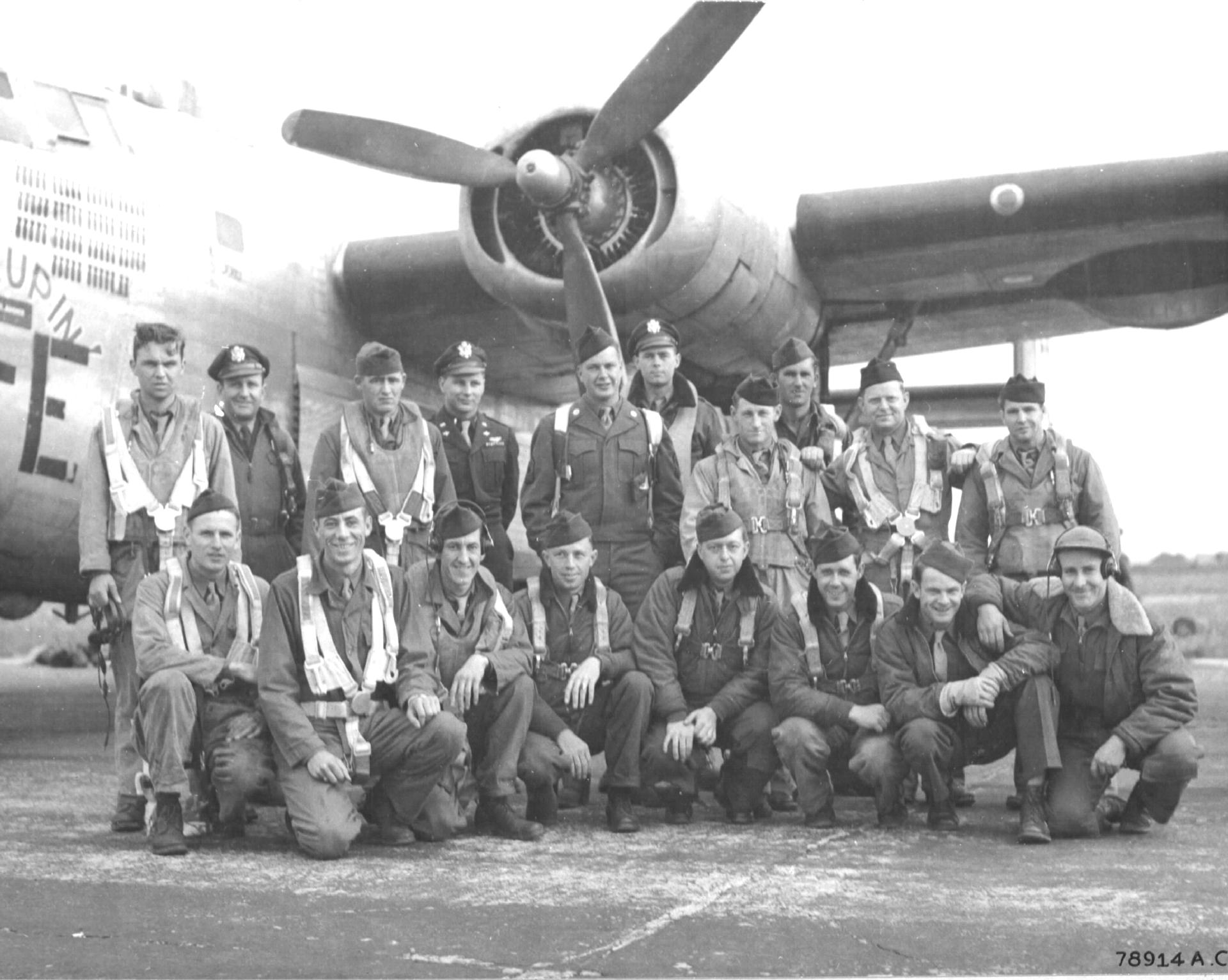
Members of the Burman Crew and ground men prepare to leave for the States
7 June 1945
Under authority contained in Letter ETOUSA, Subject: “Movement Orders, Shipment 10060”, File No. AG 370.5, OPGC, Dated 27 May 1945, the following A/C and personnel assigned thereto will proceed via Valley A/D by best available air route to Bradley Field, Windsor Locks, Connecticut, thence to Camp Miles Standish, Boston, POE. Personnel will report to the AAF Base Commander at Bradley Field. AAF personnel are being returned for the purpose of authorized TD for rest and recuperation and for further assignment. Personnel listed on this order are on Detached Service and are being accounted for on Morning Report of the Air Echelon of the Squadron to which they are asgd. TDN 212/50425 FSA 1942-45 60-136 P-431-02.
Shipment No. 10060-TZ T-M-S: B-24J A/C Serial No. 42-50502 Crew No. 11 of 18
| Name | Grade | Arm/Svc | ASN | Crew Spec/Job | MOS | Home |
|---|---|---|---|---|---|---|
| Burman, Robert W | 1Lt | AC | 718854 | Pilot | 1092 | Tacoma, WA |
| Etscheid, Elmer G | 2Lt | AC | 829442 | Co-pilot | 1092 | Chicago, IL |
| Putman, Harvey I | 2Lt | AC | 02065183 | Navigator | 1034 | Corpus Christi, TX |
| Ebbing, Alfred J | T/Sgt | AC | 16074864 | Flight Engineer | 748 | Quincy, IL |
| Clark, Junior K | T/Sgt | AC | 36726064 | Radio Operator | 757 | Woodlawn, IL |
| Peifer, Jr, John F | S/Sgt | AC | 33232518 | Gunnery Instructor | 938 | Camphill, PA |
| Sargut, Stanley F | S/Sgt | AC | 11058188 | Armorer-Gunner | 612 | Gardner, MA |
| Buening, Walter B | S/Sgt | AC | 16053159 | Gunnery Instructor | 938 | Effingham, IL |
| Grauer, Frederick M | Sgt | AC | 12099161 | Gunnery Instructor | 938 | New Hartford, NY |
| Kincaid, Jr, Lee C | S/Sgt | AC | 35668195 | Gunnery Instructor | 938 | Knoxville, TN |
| Zort, Gerrit | M/Sgt | AC | 39082406 | Crew Chief | 750 | Fergus Falls, MN |
| Koncel, Frank J | Sgt | AC | 16101276 | Airplane/Engine Mech | 747 | Chicago, IL |
| Hinman, Robert R | M/Sgt | AC | 11038621 | Crew Chief | 750 | Mt Horch, WI |
| Chuchvara, John T | S/Sgt | AC | 33756693 | Clerk-Typist | 405 | De Lancey, PA |
| Meadows, William V | S/Sgt | AC | 14072917 | Airplane Armorer | 911 | Franklin, NC |
| Lavelle, Earl M | M/Sgt | AC | 37038951 | Airplane Armorer | 911 | Greeley, NE |
| Nelson, Harry T | Cpl | AC | 14161386 | Power Turret/Gunsight Mech | 678 | Shelbyville, TN |
| Peterson, John E | Pfc | AC | 17071645 | Airplane Armorer | 911 | Lin Grove, IA |
| Pope, Jr, John D | S/Sgt | AC | 38307684 | Clerk, General | 55 | Dallas, TX |
| Byrd, Floyd E | Pfc | AC | 34802072 | Duty Soldier III | 590 | Tuscumbie, AL |
Courtesy: Alice Burman

